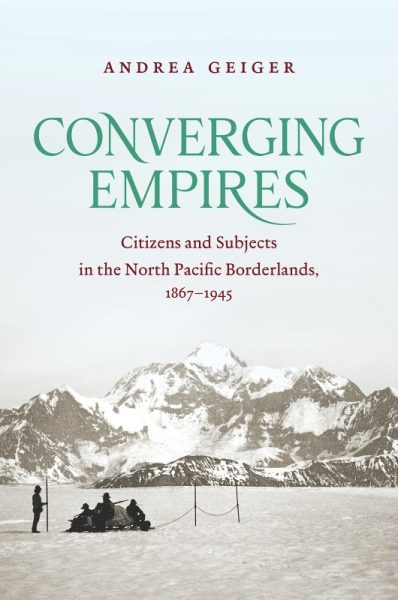
Converging Empires: Citizens and Subjects in the North Pacific Borderlands, 1867-1945
Review By Jennifer Seltz
February 22, 2024
BC Studies no. 220 Winter 2023/24 | p. 115-116
Scale and perspective shape borderlands’ meanings. Andrea Geiger’s Converging Empires begins with a cartographer’s view, as if from far above, of islands and peninsulas from the San Juans to the Aleutians to Hokkaido, now incorporated into the United States, Canada, Russia, and Japan. As Geiger notes, though, relatively few mapmakers, particularly in Atlantic-oriented Canada and the United States, have seen how these places “sketch an arc” linking North America and Asia (1). The book ends with a more constricted ground-level view, as an early 20th-century Japanese immigrant looks out at the ocean from a North American shore and imagines the North Pacific as a space of separation and connection. In the five chapters between the evocation of these two viewpoints, Geiger shows how longstanding North Pacific borderlands became sites of imperial and national competition by the end of the eighteenth century, and sites for the production and evasion of new categories of race and identity in the nineteenth and twentieth centuries. Converging Empires focuses on the sometimes parallel and sometimes entangled experiences of Indigenous people and Japanese migrants with shifting legal and political regimes on both sides of new national borders, in the years between the United States’ acquisition of Alaska and the end of World War II. Geiger builds a sophisticated argument about the relationships between these two groups by telling this history at a variety of scales, and by making scale itself a key part of her analysis.
The book begins at the longest temporal and perhaps the most familiar geopolitical scales, with a model narrative of how the northwestern coast of North America became “contingent borderlands,” as empires and nations far from the North Pacific staked claims to the homelands of a range of maritime peoples. (52) Geiger shows how American understandings of earlier Russian claims in the eastern Pacific, and Canadian understandings of British power, allowed both nations to ignore Indigenous presence and sovereignty from the 1860s onward. Geiger also expands North American historians’ maps of 18th and 19th-century imperial contestation, explaining how Japanese presence and claims around the North Pacific rim before and after Meiji Restoration shaped European and North American maneuvers.
Geiger next zooms in on Alaska, British Columbia, and Washington in the late 19th and early 20th centuries, as Japanese immigrants and Indigenous nations negotiated new national borders and new categories of racialized national belonging. Geiger shows how agents wielding new forms of state power used each group’s mobility, and ability to negotiate these new categories, to raise fears of the other group and to limit the rights of both. As the nineteenth century drew to a close and emigration from Japan increased, Japanese immigrants in Alaska and BC, like Asian communities elsewhere in the North American West, faced organized expulsion efforts, and parallels and intersections between their experiences and Indigenous communities’ became clearer. Geiger connects the violence of these expulsions, whether implicit or realized, to the foundational violence of colonialism along the North Pacific coast since the 18th century. Both projects shared a goal of creating white settler spaces by driving out or containing Asian and Indigenous communities. Geiger also traces parallel efforts in the US and Canada to limit Asian and Indigenous rights through national, imperial, and international law despite the theoretical protection of the Reconstruction-era constitutional amendments in the United States and Japanese immigrants’ potential status as naturalized British subjects in Canada.
Geiger’s meticulous analysis of law and its ironies clarifies the dynamics of immigration, discrimination, and exclusion in North American western borderlands. An even greater strength of this book, as in her earlier scholarship, is its grounding in Japanese sources and its attention to the motives and actions of representatives of Japan’s government as well as Japanese migrants. Geiger shows how Japanese colonialism and complex Japanese attitudes toward Indigenous peoples shaped the Japanese state’s choices in the eastern Pacific as well as individuals’ reactions to life in British Columbia and Alaska, from the 1860s until World War II. The fourth chapter moves from terrestrial to marine borderlands and deftly surveys the world of multiethnic, multinational North Pacific seal, halibut, salmon, and herring fisheries from the scales of shipboard labor relations to international treaty negotiations and their breakdown by 1940. Geiger ties the catastrophes of World War II as experienced by Japanese Americans and Japanese Canadians to the half century of efforts to contain, exclude, or regulate their movements in North Pacific borderlands. The book’s final chapter makes the histories of encounters between Japanese and Indigenous people systematically visible once again. Stories of wartime separations in both communities and across families are testament to connections built in previous decades, as well as to not-so-new kinds of state power once again deployed to immobilize and coerce. Geiger’s deep research, crisp analysis of law and politics across multiple borders, and her rigorous attention to how individual lives are shaped by structures of power, make this book required reading for borderlands scholars, as well as for historians of BC; Alaska; the Pacific Northwest; and certainly of immigration and Asian North America.
Publication Information
Geiger, Andrea. Converging Empires: Citizens and Subjects in the North Pacific Borderlands, 1867-1945. Vancouver: University of British Columbia Press, 2022. 368 pp. $35.95 paper.
